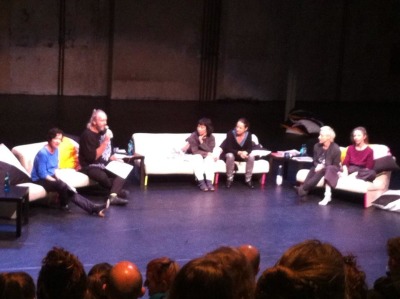Dear friends and colleagues,
this is an invitation to the “shared office #1” between the 27th of September and the 1st of October at Uferstudios Berlin. In the occasion of the upcoming HKF as well as Berliner Kulturverwaltung/Interkulturelle Projekte deadline, we want to create a space for individual writing and common concentration. Also, if you won't be working on an application, you are warmly invited to join the shared office, to write your emails, check your budgets or finish your reports.
With the shared office project, we would like to change if not the economic conditions of our work then at least the social ones. We want to find a form of solidarity that does not deny different practices, perspectives and ambitions in our work and yet still finds a place where we can be together, give each other concentration in silent late night sessions, sit next to each other sweating on deadlines and be the context for each other's ideas. We would like to provide a concentrated space that allows for the verbal or non-verbal exchange, potential cigarette talks or coffee zips and the simple courage that appears when being together. Believing that we could be a scene in many more occasions than when we meet to watch each other's shows, we want to invite you to share the crucial moment of (application) writing with us. The shared office #1 strives for being solidary in a pre-dominant competitive relation and for a little more fun while working hard.
Background
Dance and choreography has developed into a writing practice to a great extend in the past years. With the concept of a dance-maker as well as flattened hierarchies in the field, it seems to be part of almost everybody's artistic practice to sit on one's kitchen table, write emails, check budgets, create project plans, conceptualize working methods and - last but not least - write applications. The open-ing of who can be a dance maker and the discursive quality of our practice, in a funny twist, tends to individualize our work. The center of work, now, is not mainly the common rehearsal in a theater but the aforesaid kitchen table. Freelance project management and the individual pressure that goes along with it greatly affects a number of points that we care about, both for our lives as well as work: our mood, our confidence, artistic risk-taking, the exchange of ideas, the reflection on artistic practices and the support of others. With shared office #1, we want to make a first step to modify our working conditions as well as our mood.
Beyond the very practical or daily life effect, the loneliness of the kitchen table also reinforces para-meters in artistic production that we thought to have had a critical eye on already: individual author-ship and the discretion or competition with ideas and knowledge. Not denying the de facto economic and artistic competition which we are in and which we cannot simply put away with good will, we nevertheless want to support an understanding of artistic production that strives for collaboration and contextual working. We want to become a scene that gives context to each others works, that creates a social, political and artistic discourse together and that solidarizes beyond competition.
Practicalities
The office will be open between the 27th of September until the 1st of October 2014, every day from 10 am until open end. It will be set up in Atelier 62 and 64 at Uferstudios Berlin, Uferstr. 8-23. We will provide one quiet and concentrated working area with tables, chairs and sofas and a more social space with coffee and tea, a printer and some chairs and tables. Internet will be available in both places, including cable connections.
Support
Tanzbüro has generously offered support for anyone who needs an advice or information on an application. The Tanzbüro office is fifty meters away from ours and Simone and Anne will show by and are open for spontaneous requests at any time during the week. Please, let us know if you want us to ask them for a specific date.
We will be there and we hope to welcome you!
Love,
How Do We Work it*
*How Do We Work it is a new initiative of Berlin choreographers to meet, speak and reflect current working conditions in contemporary art in Berlin and internationally. We continued meeting after being once invited to the workshop “how do we work it” in the frame of the Life Long Burning Project. Rather than a group, How Do We Work it is a platform for anybody who is interested to share experiences, knowledge and ideas in monthly meetings.
 Friday, September 12, 2014 at 6:51PM
Friday, September 12, 2014 at 6:51PM 
